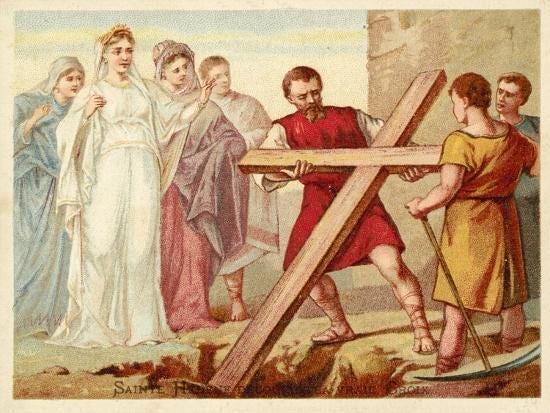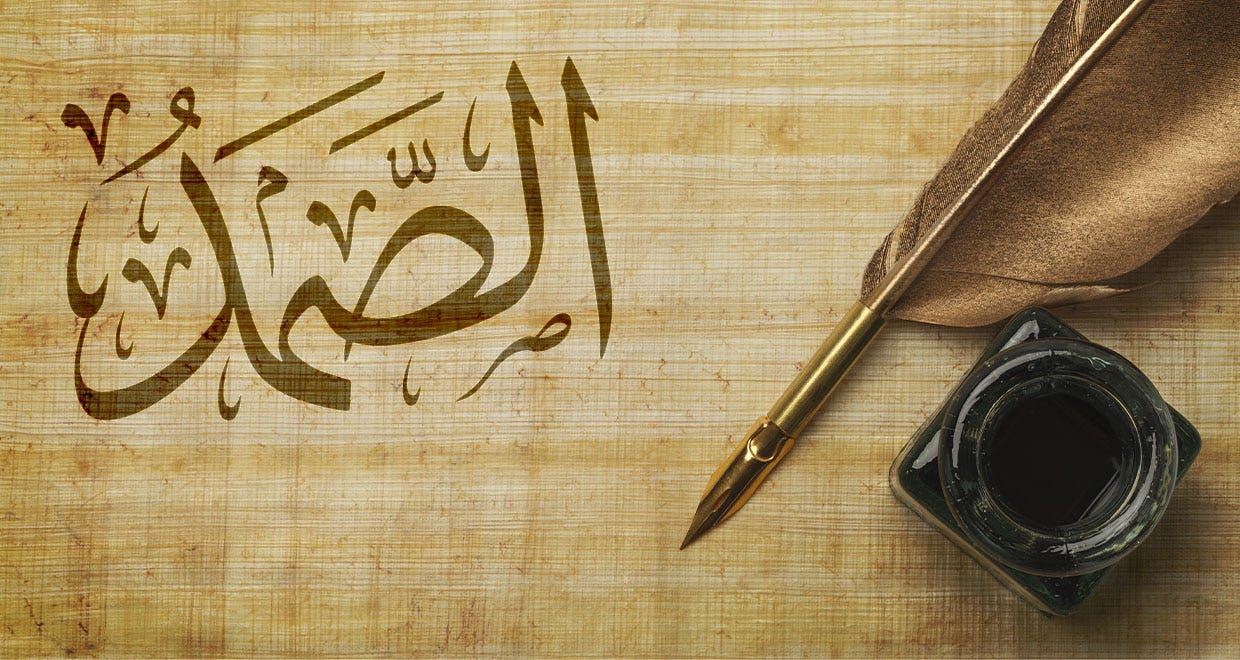σταυρός and صلب
In the process of writing my last article about the Pauline σταυρός and the Qur’anic verb صلب ṣalaba, I noticed an interesting lack of Old Testament witness to either word. There is no lexical equivalent to σταυρός nor صلب in the Hebrew scriptures. This is striking, and it breaks with Paul’s normal reliance on Old Testament terminology in order to effectively argue his case. The inclusion of novel or foreign vocabulary into his presentation of the εὐαγγέλιον would risk alienating his audience, and perhaps cause one to doubt his continuity with the scriptural tradition. Thus, he does so intentionally only when absolutely critical for the scandal of the cross. As I suggested in my previous article, Paul opts for σταυρός because of its gravitasin channeling the public spectacle and shame of the crucifixion. The Qur’an simply repurposes the Pauline σταυρός by making it cross-functional with صلب in 4:154–158, where the public scandal of the crucifixion is clear.
Syriac Christian Literature
This leads to an interesting investigation into where the Qur’an gets this vocabulary. There is a clear consonantal parallel with the Syriac (Aramaic) word ܨܠܝܒܐ ṣlība — cross which is heavily used in the liturgical traditions of Syriac Christians. The use of this word predates the Qur’an and is featured heavily in the writings of Syriac fathers such as Ephrem the Syrian and Jacob of Serugh. This is unsurprising since Syriac makes up about 70% of the loan words present in the Qur’an. This is also unsurprising given that, before the Qur’an, Syriac was the lingua franca of the entire Syro-Arabian desert and was notably influential on the development of literary Arabic. The Hijazi script of the Qur’an is also derived from Nabataean Aramaic. This places the Qur’an firmly in a Syriac milieu, despite being ultimately written in Arabic.
One would then expect the use of ܨܠܝܒܐ to be prominent in the Peshitta (Aramaic translation of the Bible), but shockingly, the word is completely absent. Instead the translators opted for ܙܩܝܦܐ zaqipa which refers to being hung, raised up, or erected. It was used previously three times in the Bible, twice in Hebrew (Ps. 145:14; Ps. 146:8) and once in Aramaic (Ez. 6:11) appearing as זָקַף zaqaf. The Arabic equivalent is زقف zaqafa — to carry off.
In the context of the Peshitta, it appears to render perfectly the Hebrew verb תָּלָה talah — to hang and its Greek counterpart κρεμάννυμι. Despite its usage in the Syriac biblical tradition, the word ܨܠܝܒܐ eventually came to prominance. Why exactly this is remains unclear. Ephrem the Syrian, for example, seems to use them as synonyms. Here a few examples from his Nisibine Hymns. The first one likens the cross, ܨܠܝܒܐ, to a staff used by a shepherd.
ܢܶܩܝܳܐ ܕܰܚܠܺܝܡܳܐ ܢܰܛܰܪ ܘܰܣܥܽܘܪ ܠܰܐܝܕܳܐ ܕܰܟܪܺܝܗܳܐܘܰܥܨܽܘܒ ܠܰܐܝܕܳܐ ܕܰܬܒܺܝܪܳܐ ܘܰܦܩܽܘܕ ܠܰܐܝܕܳܐ ܕܰܐܒܺܝܕܳܐܪܥܺܝܳܗ̇ ܒܡܰܪ̈ܓܶܐ ܕܰܟܬܳܒ̈ܶܐ ܘܰܐܫܩܳܗ̇ ܢܶܒܥܶܐ ܕܝܽܘܠܦܳܢܳܐܫܪܳܪܳܐ ܫܽܘܪܳܐ ܢܶܗܘܶܐ ܠܳܟ ܨܠܺܝܒܳܐ ܚܽܘܛܪܳܐ ܢܶܗܘܶܐ ܠܳܟܘܩܽܘܫܬܳܐ ܫܠܳܡܳܐ ܢܶܗܘܶܐ ܠܳܟ ܒܪܺܝܟ ܗ̱ܽܘ ܕܰܐܣܓܺܝܢܶܨ̈ܚܳܢܰܝܟ
Guard the sheep that are whole, and visit them that are sick, and bind up them that are broken, and seek out them that are lost; feed them in the pastures of the Scriptures, and give them drink or the spring of doctrine: let the truth be a wall unto you, let the cross (ܨܠܺܝܒܳܐ)be a staff unto you, and truthfulness be peace unto you. R., Blessed be He Who multiplied Your virtues! — Nisibis 19:4
Hymn 14 on the other hand features several references to the cross, but uses the word ܙܩܝܦܐ instead.
ܟܳܗܢܰܢ ܕܶܝܢ ܬܠܺܝܬܳܝܳܐ ܐܶܕ̈ܢܰܝ ܠܶܒܳܐ ܢܳܩܶܒ ܗ̱ܘܳܐܘܰܐܪܡܺܝ ܗ̱ܘܳܐ ܩܕ̈ܳܫܶܐ ܕܰܚܼܫܰܠ ܡܶܢ ܨ̈ܶܨܶܐ ܕܶܐܬܩܒܰܥܘ̱ ܗ̱ܘܰܘ ܒܰܙܩܺܝܦܳܐ ܕܰܙܩܼܰܦ ܡܳܪܶܗ ܘܰܐܚܺܝ ܗ̱ܘܳܐ ܠܰܟܢܰܘ̈ܳܬܶܗ
But our priest who was the third — pierced through the ears of the heart: — and fastened there the earrings he had fashioned — of the nails that were fixed in the cross (ܒܰܙܩܺܝܦܳܐ), — whereon his Lord was crucified (ܕܰܙܩܼܰܦ) — and gave life to His fellow-men. — Nisibis 14:6
Jewish Aramaic Literature
Another set of influential Aramaic literature of the time was the Talmud, which was in the process of being compiled and redacted. Because the Jews wrote in both Hebrew and Aramaic, they used all three words ( זָקַף ,תָּלָה, and צָלַב)to describe hanging/crucifixion. In Sanhedrin 43a, Jesus’ execution is referenced however the authors do not use צָלַב ṣalab but rather תָּלָה.
בערב הפסח תלאוהו לישו
On Passover Eve they hung (תלאוהו) the corpse of Jesus. — San. 43a
Interestingly, this literature attributes Jesus’ death to stoning rather than the hanging itself.
וילמד עליו ולא מצאו לו זכות ותלאוהו בערב הפסח
And the court did not find a reason to acquit him, and so they stoned him and hung his corpse on Passover eve. — San. 43a
This seems to have been a polemical tactic against Christians by aligning the death of Jesus more with the curse from Deuteronomy 21:23, with his corpse being hung in public view rather than his execution happening from crucifixion.
Christians in response, may have started to use ܨܠܺܝܒܳܐ to emphasize Christ’s death on the cross rather than by stoning. Evidence that the ṣ-l-b root denoted “fixing with nails” is corroborated in other Jewish Aramaic literature. The Mishnah (oldest part of the Talmud) includes references to צָלַב in conjuction with nails, evoking the traditional view of crucifixion.
יוֹצְאִין בְּבֵיצַת הַחַרְגּוֹל, וּבְשֵׁן שׁוּעָל, וּבְמַסְמֵר מִן הַצָּלוּב, מִשּׁוּם רְפוּאָה, דִּבְרֵי רַבִּי מֵאִיר
One may go out on Shabbat with a locust egg, and with a fox tooth, and with a nail from the crucified (הַצָּלוּב), for the purpose of healing; this is the statement of Rabbi Meir. — Shabbat 6:10
The word ܨܠܺܝܒܳܐ/צָלַב may have proven to be more directly tied to the crucifixion as described by the New Testament because of its association with fixing with nails. This theory makes sense of the Syriac Christian’s move away from the Peshitta’s ܙܩܝܦ zaqipa which simply connoted “hanging” and was therefore no more useful than the Hebrew word תָּלָה.
The Qur’an
As discussed in my last article, the Qur’an makes mention of the Jews ridiculing the Christians by saying that they “killed” the Messiah. This can clearly be seen in the writing and propagation of the Talmudic account of Jesus’ death. What is interesting though, is that the Qur’an also puts the Christians down for turning the cross into an idol. For context, in her famous pilgrimage to Jerusalem, Helena the mother of Constantine claimed to have found the remains of Jesus’ cross.
Soon thereafter, it became a relic that was venerated in the newly constructed Church of the Holy Sepulchre at the site of a previous temple dedicated to Venus. During a siege of Jerusalem by the Persians, the “true cross” was captured and taken away as loot. In 630, after a decisive victory against the Persians, Emperor Heraclius recaptured the cross and paraded it through Jerusalem in triumph. Both of these events are celebrated every year by the descendants of the Roman church (i.e. Catholics and Eastern Orthodox) in the “Elevation of the Holy Cross”.
The Qur’an, being the ultimate idol smasher, eliminates the verb صلب in 4:157 by saying that the Jews neither killed Jesus nor crucified (صَلَبُوه) ُhim. It is interesting that the Jews merely claim they “killed” Jesus. They say nothing about crucifixion, as is corroborated by the Talmud. It is the Qur’an that jumps in and says that they didn’t crucify him.
وَقَوْلِهِمْ إِنَّا قَتَلْنَا ٱلْمَسِيحَ عِيسَى ٱبْنَ مَرْيَمَ رَسُولَ ٱللَّهِ وَمَا قَتَلُوهُ وَمَا صَلَبُوهُ وَلَـٰكِن شُبِّهَ لَهُمْ
…and for boasting, “We killed the Messiah, Jesus, son of Mary, the apostle of God.” But they neither killed nor crucified him — it was only made to appear so.
As I argued in my last article, the Qur’an is not denying the death or crucifixion of Jesus, it is cleverly halting both parties from boasting in their arrogance. The death of Jesus is not the victory of the Jews nor the Christians but God’s alone. It is he who terminated Jesus’ life on earth for his own purposes (Q. 5:117). To put it in Pauline language,
Kαὶ τὰ ἀγενῆ τοῦ κόσμου καὶ τὰ ἐξουθενημένα ἐξελέξατο ὁ Θεός, τὰ μὴ ὄντα, ἵνα τὰ ὄντα καταργήσῃ, ὅπως μὴ καυχήσηται πᾶσα σὰρξ ἐνώπιον τοῦ Θεοῦ. ’Eξ αὐτοῦ δὲ ὑμεῖς ἐστε ἐν Χριστῷ Ἰησοῦ, ὃς ἐγενήθη σοφία ἡμῖν ἀπὸ Θεοῦ, δικαιοσύνη τε καὶ ἁγιασμὸς καὶ ἀπολύτρωσις, ἵνα καθὼς γέγραπται ὁ καυχώμενος ἐν Κυρίῳ καυχάσθω.
God chose what is low and despised in the world, even things that are not, to bring to nothing things that are, so that no human being might boast in the presence of God. And because of him you are in Christ Jesus, who became to us wisdom from God, righteousness and sanctification and redemption, so that, as it is written, “Let the one who boasts, boast in the Lord.” — 1 Cor. 1:28–31
“Boasting in the Lord” is not parading a piece of wood after a military victory. Boasting in Lord is accepting God’s victory on the cross, after crushing his anointed servant and raising him up in full view of his enemies. This crushed servant is the one who God sat at his right hand, in power over all the nations until the time would come for Christ to surrender that authority back to his Father and join the rest of creation into subjection under him (1 Cor. 15:28).







